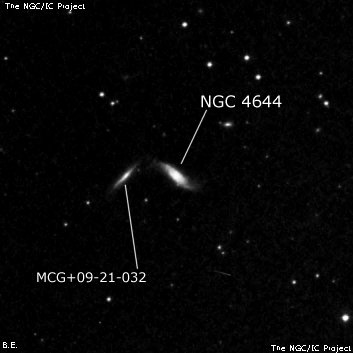
William Herschel discovered NGC 4644 = H II-794.1 = h1406 on 14 Apr 1789 (sweep 921) and noted "F, S." His re-reduced position (with respect to Epsilon UMa) is 2' west (12 sec of time) of UGC 7887. JH recorded "eF; vS; R; gbM; 10"." His position also matches UGC 7887, although he thought it was a new discovery. H II-794.1 refers to NGC 4646. See that number.
On 25 Apr 1878, Dreyer observed the field from Birr Castle, and described "3177 [NGC 4644] is eF, vS, E sp nf, small companion or star 3/4' f." The "small companion or star" is the nucleus of NGC 4644B = PGC 42725, which did not receive a NGC designation. See notes for NGC 4646 for more on this observation.
400/500mm - 18" (6/28/03): faint, fairly small, elongated 2:1 SW-NE, 0.8'x0.3', weak concentration with a slightly brighter core. Forms the north vertex of an isosceles triangle with two mag 12 star 6' SW and 6' ESE. First in a group of 6 NGC galaxies (LGG 300) with 4 on a line stretching from NGC 4644/4669/4675/4686. A very faint edge-on (NGC 4644B = PGC 42725) just 1.7' following was not noticed.
600/800mm - 24" (5/30/16): at 225x; fairly faint, moderately large, very elongated 3:1 SW-NE, 0.9'x0.3'. Contains a bright elongated core. NGC 4644 is the northernmost in a group of galaxies (LGG 300) including NGC 4669, 4675, 4686, 4695 and UGC 7905 (double).
NGC 4644 is the western component of a close pair with much fainter NGC 4644B = MCG +09-21-032 1.4' E. The companion appeared very faint, very elongated 3:1 NW-SE, 30"x10". Despite a low surface brightness, it was easier than I expected based on the SDSS magnitudes (V ~15.0).
Notes by Steve Gottlieb